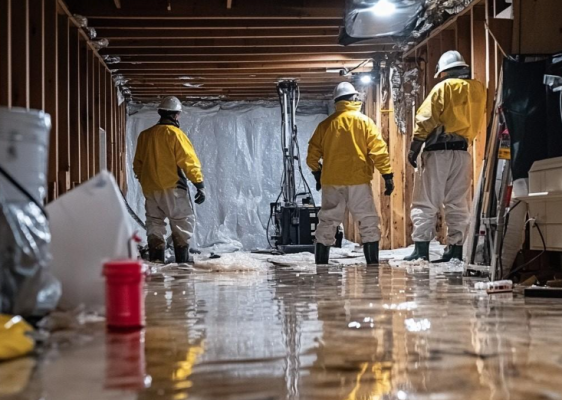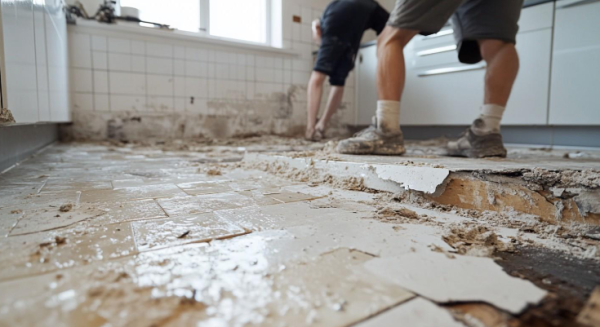Water damage can happen when you least expect it. A burst pipe, a leaking roof, or even a sudden storm can leave your home soaked and your belongings at risk.
If you’re dealing with water damage in Dallas, you need to act fast. But who do you call? And what should you expect during the restoration process?
In this article, we’ll break it all down as simply as we can, so let’s get to it.
What Is Water Damage Restoration?
Water damage restoration is the process of repairing and restoring a property that has been affected by water damage. Water extraction, drying, dehumidification, cleaning, and structural repairs are all processes utilized to restore a property to its original condition.
Pros utilize specialized tools and techniques to prevent any further damage and make sure you have a safe and healthy living space.
The Difference Between Water Damage Restoration and Water Damage Mitigation
Water damage restoration and water damage mitigation are often confused with each other, but they don’t mean the same thing.
Water damage mitigation focuses on preventing further damage by removing standing water and taking emergency measures to minimize destruction. Water damage restoration, on the other hand, involves repairing and rebuilding the affected areas and completely restoring them.
Both processes are crucial, but mitigation comes first.
Why Fast Action Matters
Water damage is a very serious problem. If not mitigated and/or dealt with accordingly, it can lead to significant issues such as mold, structural damage and health risks. That is why you need to contact a restoration service as soon as possible.
The more you wait, the more the damage gets worse. Within minutes, water can penetrate carpets, walls and furniture. Drywall begins to swell, and the wood begins to warp, and unpleasant odors form within hours.
In just a few days, mold can develop, and then it costs more to fix all the damage.
What to Expect During Your Restoration Process
Once you have called in the professionals, here is what happens next:
Step 1: Emergency Contact and Initial Assessment
When you make the call, the restoration company will ask a few important questions:
- What led to the water damage (if you know)?
- How much water is in the affected area?
- What types of materials are affected (carpet, wood, drywall, etc.)?
When they arrive, they then do a full inspection to see how much damage is there. They will use moisture meters and thermal imaging cameras to find hidden moisture pockets and to figure out the best course of action. They will assess the situation and then create a detailed restoration plan.
Step 2: Water Removal
Now, it’s time to get that water out. Pros use industrial-strength pumps and vacuums to remove standing water fast. The sooner this step is over, the less damage your home will face.
Reputable companies will have specialized equipment (submersible pumps and truck-mounted extractors) to remove this water. If the water is contaminated, technicians will take extra precautions to prevent any potential health hazards.
Step 3: Drying and Dehumidification
The moisture stays in walls, floors, and furniture after visible water is removed. High-powered air movers and professional dehumidifiers cooperate to remove this moisture.
Technicians will monitor the humidity levels and add or remove drying equipment as necessary. This is crucial for preventing the growth of mold and mildew, which can lead to long-term damage and health issues.
Step 4: Cleaning & Sanitizing
Flood damage can bring bacteria, pathogens, and mold spores into your home. In order to maintain a safe environment, professionals will:
- Use antimicrobial treatments to deep clean carpets and upholstery
- Disinfected hard surfaces (including walls and floors)
- Apply odor-neutralizing solutions to remove musty smells
- Remove unsalvageable materials
If necessary, air scrubbers and fogging equipment may be used to eliminate airborne contaminants.

Step 5: Restoration & Repairs
The last step is rebuilding your home to its pre-damaged state. The extent of repairs will depend on the severity of the damage and may include:
- Replacing soaked drywall and insulation
- Installing new flooring
- Painting and restoring trim work
- Repairing or replacing structural elements, if needed
Some restoration companies also help with dealing with insurance claims, walking a homeowner through the process to make sure they receive adequate reimbursement for their damages.
Preventing Water Damage in the Future
Although certain water damage can’t be helped (storms, for instance), here are ways to minimize the risk:
- Inspect your plumbing periodically for leaks: If left unattended, small drips can become large issues. Check pipes under sinks, behind appliances, and in basements or crawl spaces.
- Keep your gutters clean to prevent water from accumulating: Clogged gutters can cause rainwater to overflow and leak into the foundation of your home, and over the long haul, this can result in serious damage. Clean them twice a year, especially before storm season.
- Check your roof for missing shingles or cracks: Even tiny holes in your roofing can still let water in — which can lead to an expensive repair later, especially if it rains a lot. Inspect regularly for wear and tear, and fix any problems immediately.
- Know where your water shut-off valve is in case of a burst pipe: One burst pipe can fill your home with water in minutes. Turning off the water fast can help mitigate damage and save you from expensive repairs. Find your shut-off valve now so you’re prepared in an emergency.
Final Thoughts
Water damage can be very stressful to deal with, but knowing who to call and what to expect helps make it easier. If you need emergency water damage restoration Dallas, make sure to not take too long and seek the help you need.
The sooner you act, the less damage (and expense) you’ll face. Be prepared, and if you ever need these services, you know exactly what to do.









